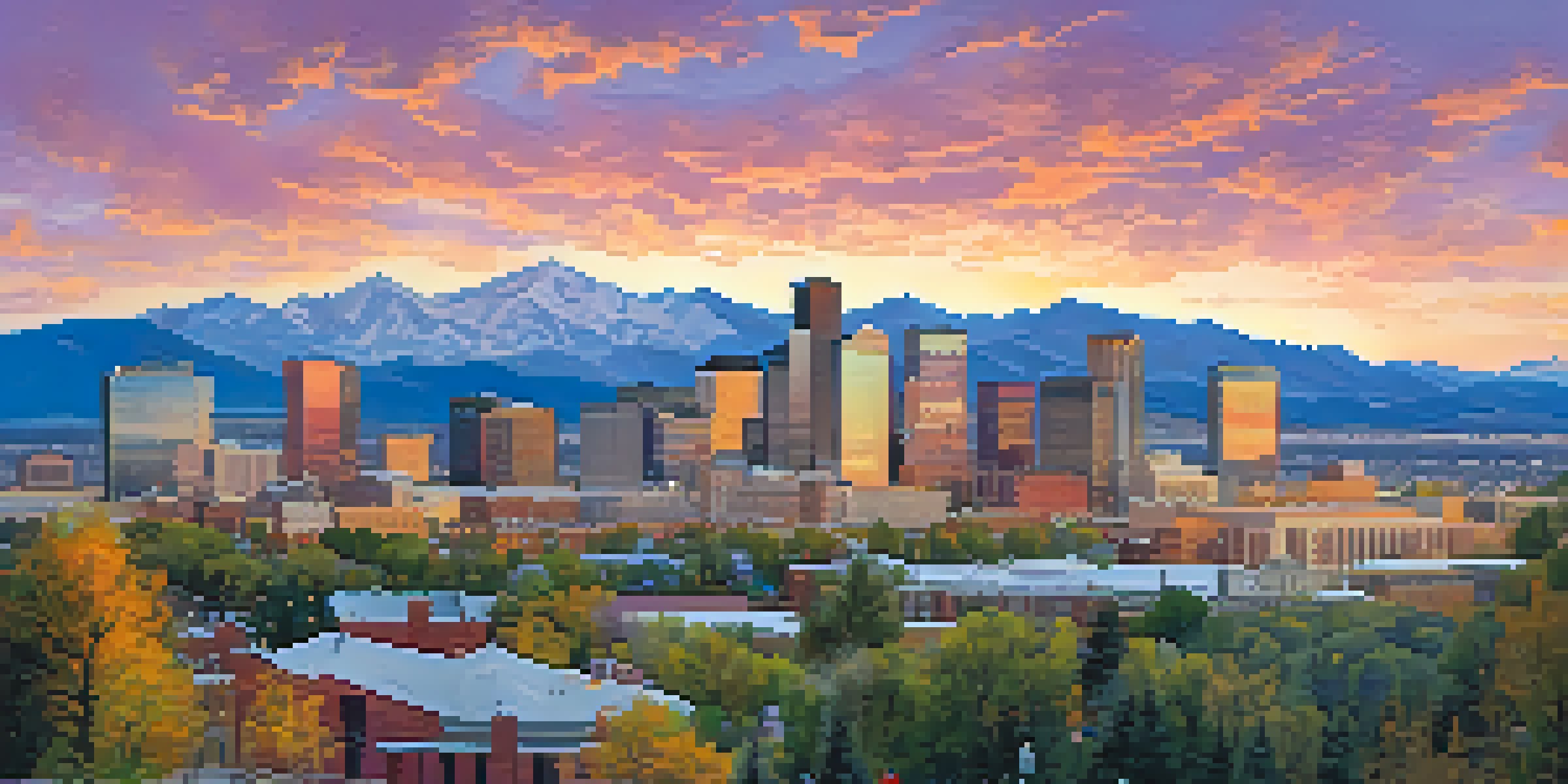Population Growth Patterns in Colorado's Major Cities

Overview of Population Growth in Colorado
Colorado has experienced significant population growth over the past few decades, making it one of the fastest-growing states in the U.S. Cities like Denver, Colorado Springs, and Aurora have seen a surge in residents drawn by job opportunities, quality of life, and natural beauty. This growth is not just a trend; it's a reflection of Colorado's evolving economic landscape and appeal to newcomers seeking a vibrant lifestyle.
The strength of a nation derives from the integrity of the home.
The state's population increase has been fueled by a mix of factors, including a robust job market in technology, healthcare, and renewable energy sectors. Young professionals, families, and retirees are all contributing to this demographic shift, each bringing unique needs and perspectives. As the population grows, so does the demand for housing, infrastructure, and services, creating both challenges and opportunities for local governments.
Understanding these growth patterns is essential for city planners and policymakers. It helps them anticipate future needs and develop strategies to accommodate a diverse and expanding population. By analyzing trends in major cities, we can gain insights into what makes Colorado an attractive destination and how it can continue to thrive amid changing demographics.
Population Trends in Denver
Denver, the state's capital, has become a magnet for new residents, with its population increasing by over 20% in the last decade. This growth can be attributed to its booming economy, vibrant culture, and outdoor lifestyle, which appeals to a diverse population. Many young professionals flock to the city for its job opportunities, particularly in tech and finance sectors.

However, rapid growth has also led to challenges, such as rising housing costs and congestion. The city is working to address these issues through initiatives aimed at increasing affordable housing and improving public transportation. As more people settle in Denver, balancing growth with quality of life remains a critical focus for city officials.
Colorado's Rapid Population Growth
Colorado has seen significant population increases, particularly in cities like Denver, Colorado Springs, and Aurora, driven by job opportunities and quality of life.
Moreover, Denver's diverse neighborhoods contribute to its unique character, attracting residents from various backgrounds. From the historic charm of Five Points to the modern developments in RiNo, there's something for everyone. This diversity not only enriches the community but also drives innovation and economic growth.
Analyzing Growth in Colorado Springs
Colorado Springs has also seen notable population growth, with an increase of nearly 15% in recent years. The city’s stunning natural surroundings, including the iconic Pikes Peak, and its strong military presence make it an attractive place to live. Many people are drawn to the area's outdoor recreational opportunities and family-friendly environment.
Growth is the only evidence of life.
The local economy is diverse, with sectors such as tourism, defense, and healthcare playing significant roles. As the population grows, so does the demand for services and infrastructure, prompting city leaders to invest in development projects that enhance livability. This growth presents both challenges and opportunities for the city’s future.
As Colorado Springs continues to expand, maintaining a balance between development and preserving its natural beauty is paramount. Residents value the city's parks and open spaces, and efforts are being made to ensure these remain accessible. The city's growth trajectory suggests a promising future, provided that it can adapt to the evolving needs of its population.
Aurora: A Rising Star in Population Growth
Aurora, located just east of Denver, is experiencing rapid population growth, with a rise of over 20% in the past decade. Known for its cultural diversity and family-friendly atmosphere, Aurora attracts a wide range of residents. The city's affordable housing and access to quality schools make it particularly appealing to families and young professionals.
The growth in Aurora is also bolstered by its strategic location, providing easy access to both Denver and the surrounding suburbs. As more residents move in, local businesses are thriving, creating a vibrant economic environment. This growth has led to an increase in amenities and services, enhancing the overall quality of life for residents.
Challenges of Urban Expansion
As populations grow, cities face challenges such as rising housing costs and infrastructure demands, necessitating proactive planning and development.
However, with this growth comes the need for careful planning. City officials must consider infrastructure improvements, public transportation expansions, and community services to meet the demands of a growing population. By addressing these challenges head-on, Aurora can continue to develop as a desirable place to live.
Impact of Migration on Population Growth
Migration plays a crucial role in shaping Colorado’s population growth patterns. Many new residents are relocating from other states, seeking better job opportunities, a higher quality of life, and the state's natural beauty. This influx of newcomers not only increases the population but also brings fresh perspectives and cultural diversity.
The reasons for migration can vary widely, from individuals seeking a change of scenery to families looking for a more supportive community. As people move to Colorado, they often contribute to the local economy, helping to create jobs and stimulate growth in various sectors. This can lead to a more vibrant community with a dynamic workforce.
However, migration also poses challenges, such as increased demand for housing and infrastructure. Cities must be proactive in addressing these needs to ensure sustainable growth. By understanding migration trends, policymakers can implement strategies to support both newcomers and long-term residents, fostering a welcoming and inclusive environment.
Economic Factors Influencing Population Changes
Economic conditions significantly influence population growth in Colorado's major cities. A strong job market, particularly in technology, healthcare, and renewable energy, attracts people from various backgrounds. This influx of workers often leads to increased demand for housing, schools, and other essential services.
Conversely, fluctuations in the economy can also impact migration patterns. For instance, during economic downturns, some residents may seek opportunities elsewhere, leading to slower growth or even population decline in certain areas. Understanding these economic dynamics is essential for city planners and businesses alike, as they can help inform future strategies.
Migration's Role in Growth
Migration from other states contributes to Colorado's population growth, bringing diversity and economic stimulation while also increasing the demand for housing and services.
Moreover, local governments are focusing on creating economic opportunities that benefit all residents. By investing in workforce development and supporting small businesses, cities can build a robust economy that attracts and retains residents. This holistic approach to economic growth is vital for maintaining the quality of life that Colorado is known for.
Future Projections for Colorado's Population
Looking ahead, Colorado's population is projected to continue growing, albeit at a potentially slower pace. Factors such as housing availability, economic conditions, and migration patterns will play a significant role in shaping this growth. Understanding these trends will be crucial for city planners and policymakers as they prepare for the future.
As cities expand, they will need to focus on sustainable development that balances growth with preserving the natural environment. This includes investing in green spaces, promoting public transportation, and ensuring affordable housing options. By prioritizing sustainability, Colorado can maintain its appeal as a desirable place to live.

Additionally, fostering a sense of community and inclusivity will be essential as the population diversifies. Cities must strive to create environments where all residents feel welcome and valued. By focusing on these aspects, Colorado can continue to thrive as a hub of growth and opportunity.
Conclusion: Embracing Change in Colorado
Population growth in Colorado's major cities is a complex and multifaceted phenomenon. It reflects a combination of economic opportunities, natural beauty, and a vibrant community life that draws people in. While this growth presents challenges, it also offers exciting possibilities for innovation and development.
As cities like Denver, Colorado Springs, and Aurora adapt to their increasing populations, they must prioritize sustainable practices and community engagement. By doing so, they can create environments that are not only livable but also thriving and inclusive. Colorado's future looks bright, provided that it embraces change while respecting its roots.
Ultimately, understanding these population growth patterns can help residents and leaders alike navigate the evolving landscape of Colorado. By working together, communities can ensure that the state remains a wonderful place to call home for generations to come.